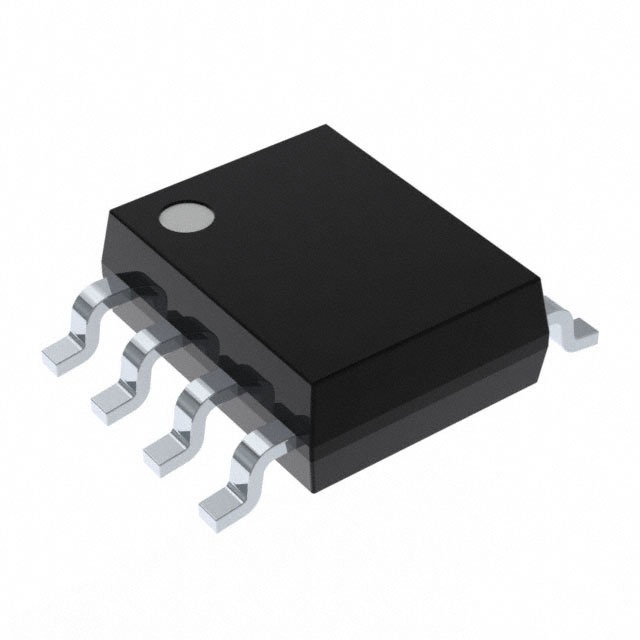Viz Specifikace pro podrobnosti o produktu.

MAX9107ESA+T
Product Overview
- Category: Integrated Circuit (IC)
- Use: High-Speed Differential Comparator
- Characteristics: Low power consumption, high speed, small package size
- Package: 8-pin SOIC (Small Outline Integrated Circuit)
- Essence: Provides accurate and fast comparison of two input voltages
- Packaging/Quantity: Tape and Reel, 2500 units per reel
Specifications
- Supply Voltage Range: +2.7V to +5.5V
- Input Voltage Range: -0.3V to +5.5V
- Operating Temperature Range: -40°C to +85°C
- Response Time: 6ns (typical)
- Propagation Delay: 4ns (typical)
- Output Current: ±20mA
- Quiescent Current: 1.5mA (typical)
Pin Configuration
The MAX9107ESA+T has the following pin configuration:
```
| | --| IN+ IN- |-- Pin 1: Non-Inverting Input (+) --| VCC GND |-- Pin 2: Power Supply (+2.7V to +5.5V) and Ground --| OUT |-- Pin 3: Output --| NC |-- Pin 4: No Connection --| GND VCC |-- Pin 5: Ground and Power Supply (+2.7V to +5.5V) --| IN- IN+ |-- Pin 6: Inverting Input (-) --| GND VCC |-- Pin 7: Ground and Power Supply (+2.7V to +5.5V) |___________| ```
Functional Features
- High-speed differential voltage comparison
- Wide supply voltage range for flexibility
- Low power consumption for energy efficiency
- Rail-to-rail input and output capability
- High output current for driving capacitive loads
Advantages and Disadvantages
Advantages: - Fast response time and propagation delay - Accurate voltage comparison - Small package size for space-constrained applications - Suitable for low-power designs
Disadvantages: - Limited output current compared to some other comparators - Noisy input signals may affect accuracy
Working Principles
The MAX9107ESA+T is a high-speed differential comparator that compares two input voltages, IN+ and IN-. It operates by amplifying the voltage difference between the inputs and producing a digital output signal based on the comparison result. The comparator has a wide supply voltage range and low power consumption, making it suitable for various applications.
Detailed Application Field Plans
The MAX9107ESA+T can be used in a wide range of applications, including:
- High-speed data communication systems
- Precision measurement equipment
- Industrial automation and control systems
- Audio and video processing circuits
- Battery-powered devices requiring low power consumption
Detailed and Complete Alternative Models
- MAX9110: High-Speed Differential Comparator with Shutdown
- MAX9111: Ultra-Fast, Low-Power, Single-Supply Comparator
- MAX9112: Dual, Ultra-Fast, Low-Power, Single-Supply Comparator
- MAX9113: Quad, Ultra-Fast, Low-Power, Single-Supply Comparator
- MAX9114: Quad, Ultra-Fast, Low-Power, Single-Supply Comparator with Shutdown
These alternative models offer similar functionality and characteristics to the MAX9107ESA+T, providing options for different design requirements.
In conclusion, the MAX9107ESA+T is a high-speed differential comparator with low power consumption and small package size. It is suitable for various applications that require accurate and fast voltage comparison. The product's specifications, pin configuration, functional features, advantages, disadvantages, working principles, application field plans, and alternative models have been discussed in detail.
Seznam 10 běžných otázek a odpovědí souvisejících s aplikací MAX9107ESA+T v technických řešeních
Sure! Here are 10 common questions and answers related to the application of MAX9107ESA+T in technical solutions:
Q: What is the MAX9107ESA+T? A: The MAX9107ESA+T is a high-speed, low-power comparator IC (integrated circuit) designed for use in various technical applications.
Q: What is the supply voltage range for MAX9107ESA+T? A: The supply voltage range for MAX9107ESA+T is typically between 2.7V and 5.5V.
Q: What is the maximum input voltage range for MAX9107ESA+T? A: The maximum input voltage range for MAX9107ESA+T is typically between -0.3V and Vcc + 0.3V.
Q: What is the typical response time of MAX9107ESA+T? A: The typical response time of MAX9107ESA+T is around 6 ns.
Q: Can MAX9107ESA+T operate in both single-ended and differential mode? A: Yes, MAX9107ESA+T can operate in both single-ended and differential mode, providing flexibility in various applications.
Q: What is the output type of MAX9107ESA+T? A: MAX9107ESA+T has an open-drain output, which allows for easy interfacing with other devices.
Q: What is the operating temperature range for MAX9107ESA+T? A: The operating temperature range for MAX9107ESA+T is typically between -40°C and +85°C.
Q: Can MAX9107ESA+T be used in battery-powered applications? A: Yes, MAX9107ESA+T is designed to operate with low power consumption, making it suitable for battery-powered applications.
Q: Does MAX9107ESA+T have built-in hysteresis? A: Yes, MAX9107ESA+T has built-in hysteresis, which helps to improve noise immunity and stability in the presence of noise or fluctuations.
Q: What are some typical applications of MAX9107ESA+T? A: Some typical applications of MAX9107ESA+T include level shifting, line receivers, window comparators, and general-purpose high-speed signal processing.
Please note that the answers provided here are general and may vary depending on specific datasheet specifications and application requirements.

